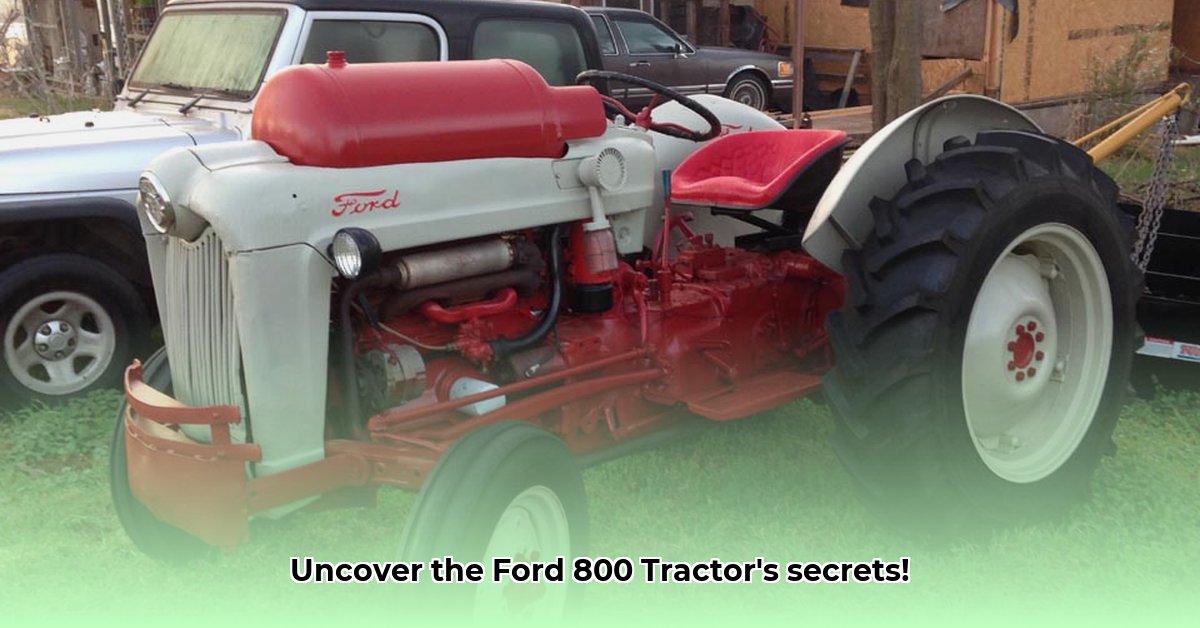
The Ford 800 series tractors, iconic symbols of post-World War II agricultural mechanization, represent more than just farm machinery; they embody a pivotal era of technological advancement and increased farming efficiency. For more precise serial number information, check out this helpful decoder. This article offers a comprehensive exploration of the 800 series, delving into its historical context, detailed specifications, evolutionary trajectory, and lasting impact on agricultural practices. We aim to provide both a technical deep dive and an engaging narrative, appealing to both enthusiasts and those interested in agricultural history.
Historical Context: A Post-War Agricultural Revolution
The Ford 800 series emerged during a period of unprecedented agricultural transformation. Post-war America witnessed a surge in demand for increased food production, coupled with a growing awareness of the need for labor-saving technologies. Farmers, facing increasing labor costs and the demands of a burgeoning population, embraced mechanization as a solution. This era saw advancements in engine technology, hydraulics, and tractor design—all of which significantly impacted the development of the Ford 800. The 800 series' strong, reliable design, and its relatively accessible price point made it a popular choice for farmers of varying scales, making it a crucial part of this transformation. How did its design reflect this need for efficiency and affordability?
Technical Specifications: A Detailed Examination
The Ford 800 series wasn't a single machine but a family of tractors, with each model embodying variations in power, capabilities, and specifications. While comprehensive historical records are limited, the following approximates the specifications of the most prevalent models: the 820, 850, and 860. Note that some figures may vary slightly, reflecting potential discrepancies across sources and manufacturing variations.
| Model | Engine Type | Horsepower (Estimate) | Transmission | Approximate Weight (lbs) | Fuel Options | Key Features |
|---|---|---|---|---|---|---|
| 820 | Gasoline (Likely a six-cylinder) | 40-50 | 4-speed manual | 3,500-4,000 | Gasoline, LP Gas | Live PTO, basic hydraulics |
| 850 | Gasoline (Likely a six-cylinder) | 50-60 | 4-speed manual | 4,000-4,500 | Gasoline, LP Gas | Improved hydraulics |
| 860 | Gasoline (Likely a six-cylinder) | 60-70 | 4-speed manual | 4,500-5,000 | Gasoline, LP Gas | Power steering (in later models), enhanced PTO |
Note: Horsepower figures represent estimates based on available data and vary depending on engine condition and testing methodologies. The weight estimations are likewise approximations due to variations in options and configurations available at the time. It's important to note that finding perfectly consistent data for these tractors is challenging, given the age and lack of comprehensive historical records.
Wasn't the variation in horsepower across models a reflection of market demands, offering farmers a choice based on their needs and acreage?
Evolution of the Ford 800 Series: Incremental Improvements
The Ford 800 series wasn't a static design. Though precise records detailing each iteration are scarce, there is evidence suggesting a clear trajectory of improvements across the various models. Subsequent models likely incorporated enhancements to engine performance, hydraulic systems, and power take-off (PTO) functionality (the shaft that powers various farm implements). These incremental upgrades reflect Ford's responsiveness to farmer needs and competitive pressures in the agricultural machinery market. For instance, later models likely included more robust hydraulic systems for handling increasingly sophisticated farm implements, although specific details and dates on changes are difficult to obtain. The gradual introduction of power steering in certain models is another notable example of this evolutionary trend. How did these subtle yet significant upgrades impact the overall efficiency and user experience for farmers?
Legacy and Impact: Shaping Modern Agriculture
The Ford 800 series left an undeniable impact on agricultural practices. Its robust design, reliable performance, and relative affordability played a pivotal role in accelerating the mechanization of farming in post-war America. It bridged the gap between simpler, less powerful tractors and the sophisticated machines of today, setting the stage for the large-scale, highly efficient agricultural operations we see now. By reducing reliance on manual labor and significantly boosting productivity, the Ford 800 tractors undeniably altered both the economic and social landscape of farming. What other lasting effects of its design and popularity can we attribute to the tractor's success?
Conclusion: An Enduring Symbol
The Ford 800 series represents much more than just a collection of tractors; it embodies a pivotal moment in American agricultural history. Its contributions extend beyond enhanced productivity, encompassing a cultural shift towards mechanization and the resulting impact on farm life. Though detailed, consistent technical data remains a challenge to completely assemble, the available information paints a clear picture of a tractor that significantly shaped farming practices for decades. This legacy continues today, with many enthusiasts actively preserving and restoring these iconic machines as testaments to the ingenuity and resilience of the post-war era.
(Note: Further research is needed to establish more precise specifications for lesser-documented models within the Ford 800 series.)